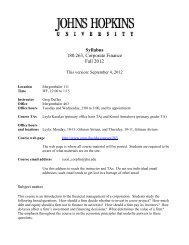WEALTH, DISPOSABLE INCOME AND CONSUMPTION - Economics
WEALTH, DISPOSABLE INCOME AND CONSUMPTION - Economics
WEALTH, DISPOSABLE INCOME AND CONSUMPTION - Economics
Create successful ePaper yourself
Turn your PDF publications into a flip-book with our unique Google optimized e-Paper software.
58<br />
E[qˆ t + 1 qˆ t + 2<br />
( qˆ t)<br />
= qˆ( k)]<br />
= φk l<br />
l = 1m<br />
= 1<br />
, φ l m<br />
, qˆ()qˆ l ( k)<br />
(A5)<br />
Terms further into the future can be constructed in a similar fashion. The<br />
solutions (A4) and (A5) bring home the magnitude of the task of computing<br />
the cumulative growth factors. The terms (A4) and (A5) are only the<br />
first two terms of an infinite summation, and this infinite summation has to<br />
be computed in every state of the system.<br />
Fortunately, there is a closed-form solution for Γ based on the<br />
approximated system, which makes the task of computing the cumulative<br />
growth factors much more manageable. Let Γ be an N × 1 vector of all the<br />
cumulative growth factors in the discrete system. In addition, let Ω be an<br />
N × N matrix with all its rows being Q , where is the transpose operator.<br />
The vector of cumulative growth factors then has the following<br />
representation:<br />
τ<br />
τ<br />
∞<br />
(A6)<br />
where • denotes element-by-element multiplication, ι is an N × 1 vector<br />
of ones, and I is the identity matrix. Computing the vector of cumulative<br />
growth factors in every state of the system therefore amounts to<br />
inverting a large matrix. With grids of 25 points, the matrix to be inverted<br />
is 625 ×<br />
625 .<br />
N<br />
∑<br />
N<br />
∑<br />
Γ ( Φ• Ω)<br />
α ∑ ι [ I – Φ •Ω]<br />
1 –<br />
= = ( – I)ι<br />
α = 1




